| Designation: | EE-T4 Ogum |
 |
|---|---|---|
| Manufacturer: | Engenheiros Especializados S.A. ENGESA | |
| Product type: | Armoured Vehicles | |
| Name: | Reconnaissance Vehicle |
While the EE-9 Cascavel armoured car and EE-11 Urutu armoured personnel carrier were initially developed to meet Brazilian Army requirements, the EE-T1 Osorio MBT and the more recent EE-T4 Ogum have been developed with an eye on the export market as well.
In the early 1980s a number of countries expressed an interest in a small light tracked armoured vehicle which could be used for a wide range of battlefield roles ranging from anti-tank armed with missiles, reconnaissance to command and control.
A Middle Eastern country stated in late 1985 that it had a firm requirement for a highly mobile light armoured vehicle weighing around four tonnes. ENGESA started detailed design work on this vehicle, subsequently called the EE-T4 Ogum (the name of an African god of war), in November 1985. The first prototype, built with company funding as a private venture, ran for the first time in May 1986. This was a considerable achievement as virtually all the automotive components of the EE-T4 were new to ENGESA and were not used in any of its existing vehicles.
The prototype of the EE-T4 Ogum was then air lifted to the Middle East for extensive trials and demonstrations under a wide range of conditions. As a result a second prototype was built with a number of improvements. This was completed in November 1986 and early in 1987 it was sent to the Middle East for trials. The EE-T4 Ogum light tracked vehicle is also being offered for local production overseas and was shown in Iraq in May 1989.
The hull of the EE-T4 is made of the famous ENGESA dual-hardness armour which consists of an outer layer of hard steel and an inner layer of softer steel roll-bonded and heat treated to give maximum ballistic protection. This armour gives protection against 7.62 mm armour-piercing attack all round. If required the vehicle could be provided with heavier armour protection but there would, of course, be a drop in the power-to-weight ratio. The small size and very low
profile of the EE-T4 Ogum also help to improve its battlefield survivability.
The glacis plate is well sloped, the driver sits at the front left with the engine compartment to his right. Forward observation is by three periscopes and over his position is a single piece hatch cover that swivels to the right.
On the second prototype the driver's hatch opens to the left and is level with the hull roof, so providing improved forward visibility with observation through a single wide-angle periscope that can be replaced by a passive night driving periscope.
On the first prototype the driver had normal clutch, brake and accelerator pedals with the manual gear change to the right; steering was via a small steering wheel rather than sticks. As a result of user trials the manual Clark 240 V transmission with five forward and one reverse gears has been replaced by an Allison Transmission Division of General Motors AT-545 automatic with four forward and one reverse gears.
The powerpack, consisting of the engine, transmission and cooling system, is mounted to the right of the driver and can be removed as a complete unit to facilitate field replacement. Cooling air enters via louvres in the glacis plate and is expelled through louvres on the hull top to the right of the driver; the exhaust outlet is in the right side of the hull.
The EE-T4 Ogum is powered by the proven Perkins QT 20 B4 four-cylinder turbocharged diesel developing 125 hp at 2650 rpm, giving an exceptional power-to-weight ratio, at a combat weight of 4.9 tonnes, of 25.5 hp/tonne. The cooling system comprises a water-to-air radiator, air-to-air charge cooler and an air cooler for the engine and transmission. Air circulation is forced through the engine compartment by a hydraulically driven fan.
Production vehicles would be fitted with the BMW M21D24WA, four-cylinder, four-stroke turbocharged and inter-cooled diesel developing 129.2 hp at 4800 rpm coupled to a ZF 4 HP 22 automatic transmission with four forward and one reverse gears.
Power is taken from the transmission to the front drive sprockets via an ENGESA designed and built Cletrac steering system. The steering differential is coupled directly to the transmission and to the final drives. It is of the regenerative system and steering is achieved by the actuation of two brake discs on both left and right exits of the differential, controlled by the driver through the steering wheel. The steering discs have forced cooling which is provided by an electrically driven fan and is controlled by the discs' temperature.
Suspension is of the torsion bar type with four dual rubber-tyred road wheels, drive sprocket at the front, idler at the rear (in line with the drive sprocket and the same as the road wheel) and two track-return rollers.
Hydraulic double-action shock absorbers are provided at the first, second and third road wheels. The Diehl double-pin tracks have optional removable rubber pads to reduce noise and damage to roads during peacetime deployment and are fitted with grousers for improved traction in soft soil. The brake system is a servo-hydraulic brake cylinder with two caliper discs mounted directly on both left and right final drives. The brake pedal is located inside the driver's
compartment with parking brake being of the mechanical type and located at the differential inlet.
The Ogum has two fuel tanks, one either side of the rear personnel compartment. On the first prototype the batteries were on the floor but on the second prototype they have been moved to the left sponson where they are much easier to check as well as leaving the floor clear for troops or cargo.
The area to the rear of the engine and the driver's compartment is clear so that the vehicle can be adopted for a wide range of roles.
The prototype has an armoured hull top on which is mounted an ENGESA cupola with an externally mounted 12.7 mm M2 HB machine gun which can be aimed and fired from within the vehicle. Two electrically operated smoke dischargers are mounted on either side. The second prototype has been fitted with an ENGESA one-man turret armed with twin 7.62 mm machine guns.
Using the same basic chassis the following versions of the EE-T4 Ogum
have been proposed:
This would carry four troops in addition to the driver and be armed with a roof-mounted 7.62 mm MG, with 200 rounds of ready use ammunition with a further 800 rounds being carried inside the vehicle. The superstructure to the rear of the driver's position has been raised and in the roof is a circular hatch cover on the left side, where the 7.62 mm machine gun is fitted. In addition, there are two roof hatches that open on either side of the vehicle; the troops would normally enter the vehicle via a door in the hull rear.
Mounted over the rear of the vehicle is an ENGESA one-man turret armed with twin 7.62 mm machine guns with an elevation of +55º and a depression of -7º with turret traverse a full 360º. In addition to the roof-mounted periscopic sight for aiming the weapons, four observation periscopes can be installed, as can two smoke dischargers either side of the turret.
This would be fitted with a turret that can be traversed through afull 360º and mounted either side would be an ATGW.
This would be fitted with a one-man turret which has an externally mounted 12.7 mm machine gun with 100 rounds of ready use ammunition and two smoke dischargers mounted either side of the turret. In addition to the roof-mounted periscopic sight, the gunner also has three observation periscopes.
This would be fitted with a one-man turret armed with an externally mounted 20 mm cannon with 100 rounds of ammunition for ready use and a further 200 rounds in reserve in the turret. Weapon elevation is from -10 to +45º with turret traverse a full 360º. In addition to the day/night periscope for aiming the weapons, the gunner also has four observation periscopes.
ENGESA has proposed that a stretched version could be built with a longer hull and that this could be used for a wide range of roles including ambulance, command post vehicle and ammunition resupply vehicle.
The 120 mm mortar carrier would be similar in concept to the former Soviet 240 mm self-propelled mortar M-1975 (SM-240) (2S4), with the mortar in the horizontal position for travelling and then swung through about 140º into the firing position, its baseplate placed on the ground to provide a more stable firing platform. This version would only be able to carry a few 120 mm mortar bombs so would normally be supported by another Ogum carrying additional ammunition.
ENGESA would offer various optional equipment on production vehicles such as night vision equipment, engine and/or crew compartment fire-extinguishing system, air-conditioning system and so on.
|
||||||||||||||||||||||||||||||||||||||||||||
|
|||||||||
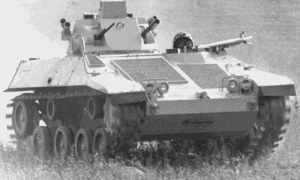 |
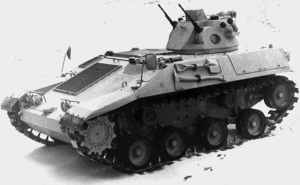 |
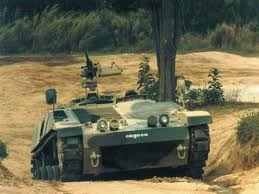 |
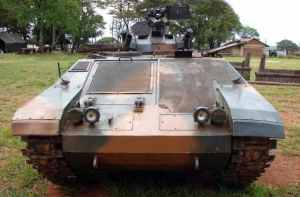 |
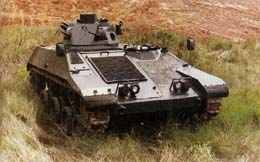 |
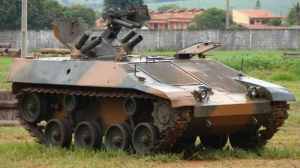 |
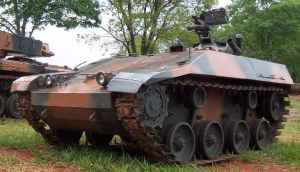 |
.jpg) |
.jpg) |
.jpg) |
